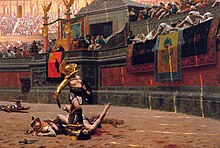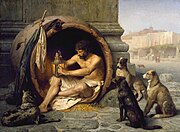Jean-Léon Gérôme
Jean-Léon Gérôme (born May 11, 1824 in Vesoul , Haute-Saône department , † January 10, 1904 in Paris ) was a French history painter and sculptor .
Life
Jean-Léon Gérôme, the son of a goldsmith, came to Paris at the age of 17. Here he was a student of Paul Delaroche , whom he accompanied on a trip to Italy in 1844 . He fell ill on the trip and had to return to Paris after a year. Here he continued his studies with Charles Gleyre .
In 1847 Gérôme made his debut at the Salon de Paris with his painting Un combat de coqs (Cockfight) , for which he received an award. The art critic Théophile Gautier was impressed by his assessment of the work. Gérôme then regularly took part in this annual art exhibition and won other prizes. After his success at the salons received numerous commissions, especially for large-format historical paintings.
His preferred subjects include orientalism as well as historical and mythical subjects. His travels to Turkey (1854) and Egypt (1857) had a major influence on his painting . Gérôme was a bitter opponent of Impressionism .
In 1863, the Paris École des Beaux-Arts appointed him professor. In 1875 he was elected a member of the American Academy of Arts and Sciences ; In 1878 he was accepted into the Legion of Honor ; other memberships were given to him in the Royal Academy of Arts (1869, Hon RA) and the Académie des Beaux-Arts .
Gérôme married Marie Goupil (1845–1912), the daughter of the art dealer Adolphe Goupil (1806–1893) , in January 1863 . The couple lived on Rue de Bruxelles in Paris. Their relationship resulted in four daughters and one son (Jean, † 1891 at the age of 27).
Almost 80 years old, Gérôme died on January 10, 1904 in Paris. His funeral in the Montmartre cemetery took place with military honors. His grave is adorned by a mourning statue designed by him.
Works
Gérôme's work is attributable to academic realism . A typical painting for him is Pollice Verso from 1872. It is considered one of the most outstanding works on gladiators and the image that shaped today's ideas about gladiator fights. Gérôme had carried out extensive research and intensively studied armaments excavated in Pompeii , so his painting is based on the state of research at the time. The combination of items of equipment is not correct according to today's knowledge, but Pollice on the reverse accurately reproduces the atmosphere of the decisive moment: Under the light filtered through the awning , an excited crowd is sentenced to death for the defeated fighter. Even the white-clad vestals , who always attended the gladiatorial fight, which is considered a state act, allow themselves to be carried away to the deadly gesture, which in Roman times was not documented as a thumb pointing downwards. However, both the awning and the privileged seat of the Vestal Virgins are historically documented. Director Ridley Scott said he was inspired by this painting for his 2000 film Gladiator . Less well known are Gérôme's portraits of people from French history, including those of Louis XIV , Molières and Marshal Michel Neys . Gérôme also worked as a sculptor. His Bellona made of ivory, metal and precious stones was exhibited at the Royal Academy of Arts in London , his group of figures Bacchus and Cupid was awarded a gold medal by the Paris Salon in 1881.
Gérôme's life-size marble nude Tanagra was one of the sensations at the Paris Salon of 1890. The very detailed personification of the ancient city of the same name holds a terracotta figure on the outstretched left palm, which referred to the Tanagra figures , which were very popular at the time . His painted nude figure Corinthe made of plaster depicts a seated woman dressed only with head, breast and arm decorations.
A painting by Gérôme from 1874, Saint Jerome , which was 'rediscovered' in the depot of the Städel Art Institute in Frankfurt in 2009 , was shown to the public for the first time in 2011 after a restoration. The painting was donated to the museum in 1935 by the heirs of the Frankfurt banker Otto Hauck and immediately placed in the depot.
Other of his works have titles such as:
- Un combat de coqs (A cockfight), 1846. Musée d'Orsay, Paris.
- Diogène ( Diogenes ), 1860. Walters Art Museum, Baltimore, Maryland.
- Phryné devant l'aéropage ( Phryne before Areopagus ), 1861. Kunsthalle Hamburg .
- Portrait of Baronne Nathaniel de Rotschild , 1866. Musée d'Orsay, Paris.
- Marché d'esclaves ( Slave Market ), 1866. Clark Art Institute , Williamstown ( Massachusetts ).
- Death of Julius Caesar (death of Julius Caesar ), 1867. Walters Art Museum , Baltimore ( Maryland ).
- Femme nue allongée (Reclining Nude ), 1869. Musée d'Évreux , Évreux
- Un Bachi-bouzouk (Ein Başı Bozuk ), 1869. Metropolitan Museum of Art (New York City).
- La prière à la mosquée (Prayer in the Mosque), 1871. Metropolitan Museum of Art ( New York City ).
- Le Veneur nègre (The Black Hunter), 1871. Private collection.
- Bain turc (Turkish bath), 1872. Museum of Fine Arts , Boston ( Massachusetts )
- Pollice Verso (Thumbs Down), 1872. Phoenix Art Museum , Phoenix ( Arizona ).
- L'éminence grise (The Gray Eminence), 1873. Museum of Fine Arts, Boston, Massachusetts
- Portrait of Charles Garnier , 1877. Bibliothèque-musée de l'Opéra , Paris.
- Vente d'esclaves à Rome (slave sale in Rome), 1884. Walters Art Museum, Baltimore, Maryland.
- Pygmalion et Galathée ( Pygmalion and Galateia ), 1890. Metropolitan Museum of Art (New York City).
- Tanagra , 1890. Musée d'Orsay, Paris.
- Le marchand de couleurs (The Paint Dealer), 1891. Museum of Fine Arts, Boston, Massachusetts
- Portrait of Baron Alphonse Delort de Gléon , 1894. Louvre , Paris.
- Portrait of Sarah Bernhardt , around 1895. Musée d'Orsay , Paris.
- La Vérité sortant du puits armée de son martinet pour châtier l'humanité , 1896
student
- Georges Bigot (1860-1927)
- Frank Boggs (1855-1926)
- Frederick Arthur Bridgman (1847-1928)
- Gustave Caillebotte (1848-1894)
- Mary Cassatt (1844-1926)
- André Castaigne (1861-1929)
- George W. Chambers (1857-1897)
- Stanislaus von Chlebowski (1835-1884)
- Kenyon Cox (1856-1919)
- Edward Cucuel (1875-1954)
- Dennis Miller Bunker (1861–1890)
- Pascal Adolphe Dagnan-Bouveret (1852-1929)
- William DeLeftwich Dodge (1867-1935)
- Thomas Millie Dow (1848-1919)
- Thomas Eakins (1844-1916)
- Wyatt Eaton (1849-1896)
- Delphin Enjolras (1857–1945)
- Osman Hamdi Bey (1842-1910)
- Thomas Alexander Harrison (1853-1930)
- Henry Herbert La Thangue (1859-1929)
- Robert Lee MacCameron (1866-1912)
- Henri-Paul Motte (1846-1922)
- Henry Siddons Mowbray (1858-1928)
- Jean Lecomte du Nouÿ (1842–1923)
- Lawton S. Parker (1868-1954)
- Harper Pennington (1854-1920)
- Georges Picard (1857-1943)
- William Picknell (1853-1897)
- Émile Auguste Pinchart (1842-1924)
- Théodore Jacques Ralli (1852–1909)
- Henri Rapin (1873-1939)
- Odilon Redon (1840-1916)
- Julius Stewart (1855-1919)
- William Stott (1857-1900)
- Abbott Thayer (1849-1921)
- Douglas Volk (1856-1935)
- Charles Vuillermet (1849-1918)
- Julian Alden Weir (1852-1919)
- Wassili Wassiljewitsch Vereschtschagin (1842–1904)
- Yamamoto Hōsui (1850-1906)
Exhibitions
- 2010/2011: Jean-Léon Gérôme , Musée d'Orsay , Paris (until January 2011); then in the Museo Thyssen-Bornemisza , Madrid (until May 2011)
literature
- Gerald M. Ackerman: Jean-Léon Gérôme. Monograph révisée, catalog raisonné mis a jour. ACR, Courbevoie 2000, ISBN 2-86770-137-6 .
- Gerald M. Ackerman: Jean-Léon Gérôme (1824-1904). Sa vie et son oeuvre. ACR, Courbevoie 1997, ISBN 2-86770-100-7 .
- Alexandra Hein: Between documentation and illusion. The oriental motifs in the work of Jean-Léon Gérôme. 2 volumes. Frankfurt am Main 1996.
- Helene B. Weinberg: The American pupils of Jean-Léon Gérôme. Amon Carter Museum, Fort Worth, Texas 1984, ISBN 0-88360-049-8 .
- Alberto Shayo : Statuettes art deco period. Antique Collectors Club Art Books, 2016, ISBN 1-85149-824-9 , p. 100.
Web links
- Literature by and about Jean-Léon Gérôme in the catalog of the German National Library
- Jean-Léon Gérôme (1824-1904). The story is brought back to life , Musée d'Orsay 2010 [1]
Individual evidence
- ↑ a b c d e Historical Dictionary of Romantic Art and Architecture . Scarecrow Press, 2011, ISBN 0-81087-473-3 , pp. 102f.
- ^ A b Marius Roux, Dick Collins, Paul Smith: The Substance + the Shadow. Penn State Press, 2007, ISBN 0-27103-205-7 , pp. 20.M.
- ↑ Julia Reuter, Alexandra Karentzos: Key Works of Postcolonial Studies. Springer-Verlag, 2012, ISBN 3-53193-453-8 , p. 255.
- ^ Allison Lee Palmer: Art + Paris Impressionists & Post-Impressionists. The Ultimate Guide to Artists, Paintings and Places in Paris and Normandy. Museyon, 2011, ISBN 1-93845-024-8 , p. 182.
- ^ Alberto Shayo : Statuettes art deco period. Antique Collectors Club Art Books, 2016. ISBN 1-85149-824-9 , p. 100.
- ^ Jean Léon Gérôme Hon RA (1824-1904). In: royalacademy.org.uk
- ↑ Hélène Lafont-Couturier, Goupil & Cie, Frick Art & Historical Center: Gérôme and Goupil. Réunion des Musées Nationaux, Paris 2000, ISBN 2-71184-152-9 , p. 72.
- ↑ Gerald M. Ackerman: The life and work of Jean-Léon Gérôme, with a catalog raisonné. Sotheby's, 1986, p. 62.
- ↑ Gerald M. Ackerman: Jean-Léon Gérôme. His Life, His Work, 1824-1904. ACR édition, 1997, ISBN 2-86770-101-5 , p. 170.
- ^ Eckart Koehne, Cornelia Ewigleben, Ralph Jackson: Gladiators and Caesars: The Power of Spectacle in Ancient Rome. Museum für Kunst und Gewerbe Hamburg, Historisches Museum der Pfalz (Speyer, Germany), 2000, ISBN 0-52022-798-0 , p. 31f.
- ^ Pollice Verso - Thumbs Down. ( Memento of April 17, 2010 in the Internet Archive ) In: Kings Galleries |
- ^ Robert Rosenblum, Horst Woldemar Janson: Nineteenth Century Art. Edition 2, revised. Prentice Hall, 2005, ISBN 0-13189-614-8 , p. 485.
- ↑ What a find! In: Frankfurter Allgemeine Zeitung of August 20, 2011, p. 23; Hans-Joachim Müller: Treasures from the depot - that is no longer canon . In: welt.de of November 17, 2011
- ^ Jean-Léon Gérôme (1824–1904). In: Museo Thyssen-Bornemisza
| personal data | |
|---|---|
| SURNAME | Gérôme, Jean-Léon |
| BRIEF DESCRIPTION | French history painter and sculptor |
| DATE OF BIRTH | May 11, 1824 |
| PLACE OF BIRTH | Vesoul |
| DATE OF DEATH | January 10, 1904 |
| Place of death | Paris |










